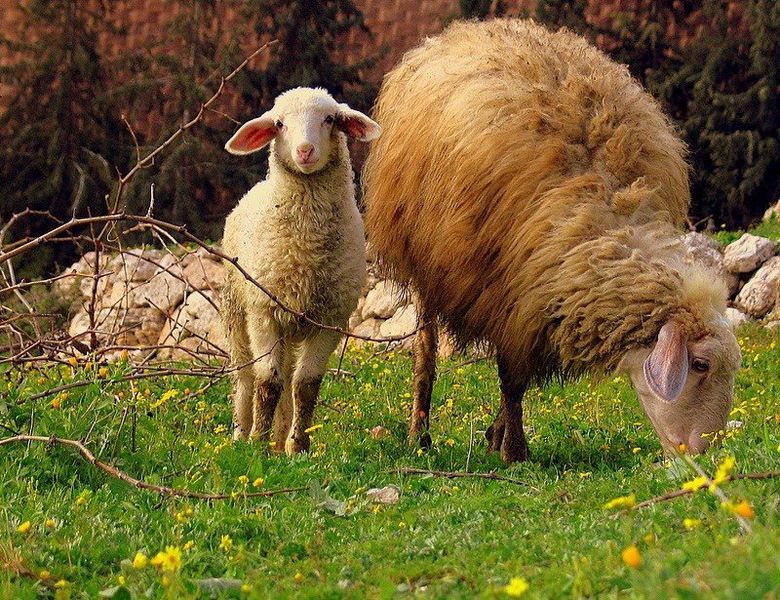 We begin this week with a shout out, to Moishe Rabaynu whose birthday and yurtzeit (day of his passing) were both observed this past Sunday, on Zayin Adar (the 7th day of the month of Adar). We shout him out davka because his name -as anyone who went to yeshiva would know- is nowhere to be found in this week’s parsha of Tetzaveh. Why is his name missing? What terrible sin did Moishe possibly commit that he went missing from the parsha? We shall efsher briefly explore that later.
We begin this week with a shout out, to Moishe Rabaynu whose birthday and yurtzeit (day of his passing) were both observed this past Sunday, on Zayin Adar (the 7th day of the month of Adar). We shout him out davka because his name -as anyone who went to yeshiva would know- is nowhere to be found in this week’s parsha of Tetzaveh. Why is his name missing? What terrible sin did Moishe possibly commit that he went missing from the parsha? We shall efsher briefly explore that later.
Raboyseyee and Ladies:
Forbidden Clothing
Let’s begin with a comment received from Rachel Senner of Teaneck, New Jersey, who wrote and asked azoy:
A mixture of wool and linen – shatnez, is prohibited in clothing, and rabbinically in curtains as well, since one may come to wrap themselves in the curtain for warmth. But we are also reading that the curtains in the Sanctuary and the clothing of the priests contained both wool and linen. How did that work?! How can the same Torah that instructs us not to wear shatnez, instruct us to use both wool and linen for specific holy purposes??
Rachel Senner
Rachel taka asks a givaldige and timely question as ‘bigday kihuna’ (priestly clothing) take center stage this week. 43 of 101 pisukim of the parsha are dedicated to clothing and their design. The RBSO will give Moishe very detailed and specific instructions on the fabrics to be used, how they were to be sewn and or woven, and the colors of the items. He wanted his koihanim looking sharp. According to many, the 99th mitzvah in the heylige Toirah is for the koihanim to don custom made garments designed and selected by the RBSO Himself to be worn while performing their avoido (service) in the Mishkan, and years later, in the Beis Hamikdash. Says the heylige Toirah (Shemois 28:2): “And you shall make holy garments for Aharoin your brother for splendor and beauty.” How serious was the RBSO about this dress code? Very! Any service performed without the proper uniform was rendered invalid. Dress down days would only be introduced centuries later.
 Lest you think this was the first time the RBSO designed clothing, you would be wrong. We need to hearken back to parshas Bereishis where we first met Odom and Chava. The heylige Toirah tells us that they were enjoying Gan Eden (Paradise) while prancing around nakiteeheyt (totally naked), not a care in the world. And why not? Who was going to see them? The neighbors? Ober, it appears that the nochosh (snake) did efsher see Chava, did slither up to her, did seduce her into eating from the forbidden fruit, and shoin. (One medrish will teach us that the snake, still walking upright at the time, also seduced Chava physically.) A few pisukim later we will learn that they suddenly discovered their nakedness, it embarrassed them. What to do? The RBSO fashioned clothing made of leather to cover their privates. One medrish will tell us that the word ‘beged’ meaning an article of clothing, is also related to the word sin, and that clothes biclall (in general) are meant to remind us of the original sin of man; it is the reason we need clothing. The bottom line: Odom and Chava discovered their nakedness only once they were enlightened by the forbidden fruit. It was at that time that the yetzer horo (evil inclination) entered their souls. In real life, once the yetzer horo enters and takes control, we typically lose our clothing, if you chap, which typically follows.
Lest you think this was the first time the RBSO designed clothing, you would be wrong. We need to hearken back to parshas Bereishis where we first met Odom and Chava. The heylige Toirah tells us that they were enjoying Gan Eden (Paradise) while prancing around nakiteeheyt (totally naked), not a care in the world. And why not? Who was going to see them? The neighbors? Ober, it appears that the nochosh (snake) did efsher see Chava, did slither up to her, did seduce her into eating from the forbidden fruit, and shoin. (One medrish will teach us that the snake, still walking upright at the time, also seduced Chava physically.) A few pisukim later we will learn that they suddenly discovered their nakedness, it embarrassed them. What to do? The RBSO fashioned clothing made of leather to cover their privates. One medrish will tell us that the word ‘beged’ meaning an article of clothing, is also related to the word sin, and that clothes biclall (in general) are meant to remind us of the original sin of man; it is the reason we need clothing. The bottom line: Odom and Chava discovered their nakedness only once they were enlightened by the forbidden fruit. It was at that time that the yetzer horo (evil inclination) entered their souls. In real life, once the yetzer horo enters and takes control, we typically lose our clothing, if you chap, which typically follows.
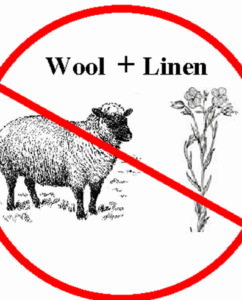 Nu, those who went to yeshiva, avada know that it’s osur mamish (verboten) for a person to wear clothing made of shatnez. Then again, cross-dressing too is forbidden, ober come Purim this coming Sunday, you will zicher see kids, teens and adults dressed in costumes of the opposite sex. What’s taka pshat? And what the hec is this shatnez Rachel asks about? Nu, given that the Oisvorfer’s review which now reaches hundreds of thousands around the world mamish, also includes many who are not (yet) observant, and a few mistama not even Yiddin -efsher they are descendants of the Erev Rav, ver veyst- let’s begin with a mitzvah loi-sah-say (thou shall not do) we will encounter later in Devorim (Deuteronomy 22:11). Says the heylige Toirah, azoy: You shall not wear shatnez, wool and linen together.” Why not? We don’t know! And we don’t know because the RBSO decided that it’s none of our business to know why: that’s what He wants and shoin. Is He asking too much from us? Not! Kimat all commentators cite this prohibition as the classic example of the “chok”- a statute- a mitzvah commanded upon us which has no readily evident reason. It is not accompanied by any logical explanation. Shoin. We avada follow the RBSO’s instructions. Grada, the observance of commandments which are beyond our comprehension demonstrate our total belief in the RBSO and His heylige Toirah. No shatnez it is, and so far so good. That is until we get to this week’s parsha (Shemois 28:6) where we come across this very specific instruction. “And you shall make the apron of gold, blue wool, purple wool, scarlet wool and fine linen twisted.” Wool and linen in one garment!? Oy vey! Ober asks Rachel, how does that mesh with the posik in Devorim (22:11) we quoted above which tells us azoy: “You shall not wear shatnez, wool and linen together.”
Nu, those who went to yeshiva, avada know that it’s osur mamish (verboten) for a person to wear clothing made of shatnez. Then again, cross-dressing too is forbidden, ober come Purim this coming Sunday, you will zicher see kids, teens and adults dressed in costumes of the opposite sex. What’s taka pshat? And what the hec is this shatnez Rachel asks about? Nu, given that the Oisvorfer’s review which now reaches hundreds of thousands around the world mamish, also includes many who are not (yet) observant, and a few mistama not even Yiddin -efsher they are descendants of the Erev Rav, ver veyst- let’s begin with a mitzvah loi-sah-say (thou shall not do) we will encounter later in Devorim (Deuteronomy 22:11). Says the heylige Toirah, azoy: You shall not wear shatnez, wool and linen together.” Why not? We don’t know! And we don’t know because the RBSO decided that it’s none of our business to know why: that’s what He wants and shoin. Is He asking too much from us? Not! Kimat all commentators cite this prohibition as the classic example of the “chok”- a statute- a mitzvah commanded upon us which has no readily evident reason. It is not accompanied by any logical explanation. Shoin. We avada follow the RBSO’s instructions. Grada, the observance of commandments which are beyond our comprehension demonstrate our total belief in the RBSO and His heylige Toirah. No shatnez it is, and so far so good. That is until we get to this week’s parsha (Shemois 28:6) where we come across this very specific instruction. “And you shall make the apron of gold, blue wool, purple wool, scarlet wool and fine linen twisted.” Wool and linen in one garment!? Oy vey! Ober asks Rachel, how does that mesh with the posik in Devorim (22:11) we quoted above which tells us azoy: “You shall not wear shatnez, wool and linen together.”
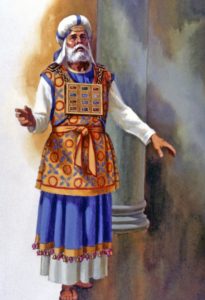 If the heylige Toirah twice told us (once in Vayikro 19) in no uncertain terms not to wear shatnez, how is it that the RBSO gave specific orders for the koihen godol (high priest), as part of his wardrobe, to don an item made specifically of these two materials? What’s taka pshat? Did the RBSO change His mind? Or, was an exception made for the clothing and for the Poroiches (curtains)? The curtain too was made from shatnez? Yikes! Nu, Rachel, we have givaldige news for you: your question was on the mind of many; let’ see what a few offered for this dichotomy.
If the heylige Toirah twice told us (once in Vayikro 19) in no uncertain terms not to wear shatnez, how is it that the RBSO gave specific orders for the koihen godol (high priest), as part of his wardrobe, to don an item made specifically of these two materials? What’s taka pshat? Did the RBSO change His mind? Or, was an exception made for the clothing and for the Poroiches (curtains)? The curtain too was made from shatnez? Yikes! Nu, Rachel, we have givaldige news for you: your question was on the mind of many; let’ see what a few offered for this dichotomy.
Ober before we do, be aware that the Oisvorfer has for years been ruminating over this issue: why taka do so many bother trying to find logic and rationale in the RBSO’s chukim? Once a chok is fully explained and rationalized, does it not lose its essence? Does it then not slide over to the category of mitzvis -both positive and negative- which are accompanied by an explanation and some logic? What then is the point of the chok? Shoin, that being said, many have written about shatnez; here’s what a few had to say.
Says the medrish (Tanchuma 9) and a few other exegetes: Kayin killed his brother Hevel following the sacrifices each brought to the RBSO. Kayin’s korban was of flax. Linen is derived from flax seeds. Hevel’s korban was from his ‘wooly’ sheep. Because the first ever murder in the heylige Toirah resulted when the RBSO accepted Hevel’s sacrifice while rejecting Kayin’s, we are instructed not to join these two materials. The combo did, after all, result in hate and then murder. Yikes!
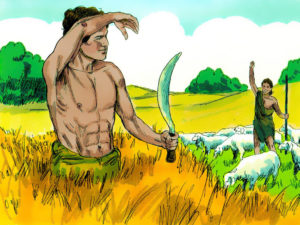 Says the Rosh: the Poroiches (curtain) over the Mishkan was taka made from wool and linen. The heylige Toirah did not want us to be wearing anything similar to the holy Poroiches. We are not to use that combination for mundane purposes. Said the Rambam (Maimonides) azoy: it was customary for the goyishe priests, those who worship avoido zoro, to wear garments made of the combination of wool and linen. It’s not for us Yiddin! He also tells us that in his time, while he was residing in Egypt (itself a subject of some controversy), the priests were such clothing. And said the Zohar: we cannot don shatnez because the word itself is a combination of two words “Satan Oz” meaning that the soton (devil) is strong. Whenever someone does wear shatnez, an “evil spirit” lurks within him as it did in the times of Kayin and Hevel when these two items clashed with calamitous results.
Says the Rosh: the Poroiches (curtain) over the Mishkan was taka made from wool and linen. The heylige Toirah did not want us to be wearing anything similar to the holy Poroiches. We are not to use that combination for mundane purposes. Said the Rambam (Maimonides) azoy: it was customary for the goyishe priests, those who worship avoido zoro, to wear garments made of the combination of wool and linen. It’s not for us Yiddin! He also tells us that in his time, while he was residing in Egypt (itself a subject of some controversy), the priests were such clothing. And said the Zohar: we cannot don shatnez because the word itself is a combination of two words “Satan Oz” meaning that the soton (devil) is strong. Whenever someone does wear shatnez, an “evil spirit” lurks within him as it did in the times of Kayin and Hevel when these two items clashed with calamitous results.
Nu, given all that rationale for why the RBSO forbade shatnez, why was shatnez then mandated for the Poroiches and the bigday kihuna? Says Rabaynu Bachaye azoy: while it’s typically the case that everything in nature has its own spiritual force and that the mixing of forces, such as the mixing of wool and linen, can compromise such forces with deleterious effects, such was not the case in the holy Mishkan and subsequent Temples. There, while performing the avoido, the RBSO ordered these forces to unite. Accordingly the RBSO not just allowed the combination of wool and linen to appear together but so ordered. Exactly what that means, ver veyst?
Ober, says the Oisvorfer, azoy: the purpose of the entire avoido (service) by the koihanim in the Temples was to help the Yiddin atone for their sins. In fact, says the heylige Gemora (Zivochim 88B), azoy: each article of clothing worn atoned for another giferliche sin. Amazingly, a total of eight garments covered all their sins. In our times, given your chazerishe behavior, if you chap, the koihanim would likely need to be layered and then some. Sin offerings were brought by those seeking repentance. Says the heylige Gemora (Yoma 86B) that tshuva, repentance, can change a sin into a mitzvah. Koihanim were empowered to change a sin such as the one committed by Kayin into a mitzvah such as the offering from Hevel. Therefore the Kohain has special dispensation: they were ordered to davka combine the forces of wool and linen. What all that means, ver veyst? The bottom line: The RBSO ordered for wool and linen to be combined at a specific time in history, in a specific place, and for certain people. For the koihanim only, and the Mishkan and Temples only. In other words: this combination of materials was ordered for special people, the koihanim to wear, while in a special place, doing special work, the avoido. We common folk may not build our own Temples and walk around in their clothing doing their work. For us, shatnez always was, and remains verboten. Veyter.
Speaking of clothing, shatnez and the koihanim, just last week we discussed how the skin of the tachash, was fashioned into one of the covers of the Mishkan. We also learned that tachash skins were also used to fashion shoes for the Yiddin. These shoes were seemingly ever-lasting and Moishe made note of the fact they the Yiddin wore their shoes -seemingly the same pair- for forty years. Ober, did everyone get shoes? Perhaps not! Though 43 pisukim of this week’s parshas are dedicated to the clothing the koihanim (priests) were to don during their avoido (service), it appears that shoes were not included. Were the koihanim left shoeless? So it would appear and taka we will come to learn that their service was performed while they were barefoot.
Shoin, we began by mentioning Moishe’s birthday, yurtzeit, and the fact that his name is nowhere to found in parshas Tetzaveh. We will end by finding out why. From his birth in parshas Shemois and through the end of Sefer Bamidbar (Leviticus), his name is always to be found -usually quite a bit- as the RBSO gives him various instructions, or stam azoy chapped a schmooze with him. Given that Moishe speaks in the first person throughout the entire Sefer Devorim (Deuteronomy), it’s avada understandable that he may not appear by name. And the question that bothered many was azoy: why taka did Moishe go missing? Though many of you have your minds on Purim and how to avoid the dozens of collectors -typically in costume- who come knocking on your door collecting for various causes and yeshivas -including a few that may have expelled you decades back- let’s close by telling you what a few had to say regarding Moishe’s disappearance from the parsha.
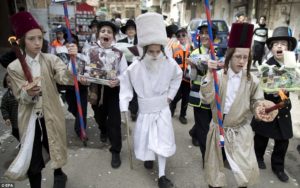 Besides Moishe’s birthday and passing, we should avada mention that this shabbis is also Parshas Zachor, the shabbis which always precedes the very joyous holiday of Purim. Yearly on this shabbis, we are commanded to remember Amolake. Why them? The Amalikites were the first nation to war with the Yiddin following their Exodus from Mitzrayim. They are charged with cooling off the Yiddin’s newfound fervor. That specifically angered the RBSO who as you know, has a long memory. Certainly that doesn’t bode well for most of us. Yearly, as we read the haftorah, we recall how shortly after the Novee Shmuel (Prophet Samuel) appointed Shaul (Saul) to be the first king of the Yiddin, the RBSO commanded that Shaul avenge what the Amalikites did by killing them all out. All meant men, women, children and even their cattle. All! Bikitzur (in short), though Shaul followed most of the instructions, he did not execute on the word ‘all.’ He showed some unwarranted rachmonis and allowed Agag, king of the Amalikites to live. (He also spared the lives of some of the fatter cattle which he would use as sacrifices.) Sensing danger, Agag chapped a quickie with his wife and impregnated her. Shoin. While Shaul was busy killing the Amalikites and capturing the king alive, Mrs. Agag, now pregnant with child, managed to escape. Seemingly, she lived happily ever after. Some 500 years later, their descendant, another bad actor by the name of Homon (Haman), plotted to kill the Yiddin. We will read his story in Migillas Esther (Book of Esther), and will celebrate his death and the miraculous victory the Yiddin enjoyed over their enemies by eating, drinking, partying, and dressing up in various costumes.
Besides Moishe’s birthday and passing, we should avada mention that this shabbis is also Parshas Zachor, the shabbis which always precedes the very joyous holiday of Purim. Yearly on this shabbis, we are commanded to remember Amolake. Why them? The Amalikites were the first nation to war with the Yiddin following their Exodus from Mitzrayim. They are charged with cooling off the Yiddin’s newfound fervor. That specifically angered the RBSO who as you know, has a long memory. Certainly that doesn’t bode well for most of us. Yearly, as we read the haftorah, we recall how shortly after the Novee Shmuel (Prophet Samuel) appointed Shaul (Saul) to be the first king of the Yiddin, the RBSO commanded that Shaul avenge what the Amalikites did by killing them all out. All meant men, women, children and even their cattle. All! Bikitzur (in short), though Shaul followed most of the instructions, he did not execute on the word ‘all.’ He showed some unwarranted rachmonis and allowed Agag, king of the Amalikites to live. (He also spared the lives of some of the fatter cattle which he would use as sacrifices.) Sensing danger, Agag chapped a quickie with his wife and impregnated her. Shoin. While Shaul was busy killing the Amalikites and capturing the king alive, Mrs. Agag, now pregnant with child, managed to escape. Seemingly, she lived happily ever after. Some 500 years later, their descendant, another bad actor by the name of Homon (Haman), plotted to kill the Yiddin. We will read his story in Migillas Esther (Book of Esther), and will celebrate his death and the miraculous victory the Yiddin enjoyed over their enemies by eating, drinking, partying, and dressing up in various costumes.
And taka this Sunday, we will be celebrating Purim and the fact that queen Esther’s encounter with the King’s scepter, if you chap, had a happy ending, if you chap, and resulted in the Yiddin being saved from the giferliche plot concocted by Homon that minuvil. The bottom line: an encounter with the scepter, unless in a yeshiva setting by a rogue rebbe, can, at times, lead to good things, if you chap. The Yiddin are commanded (by our rabbis) to celebrate yearly the great miracle of Purim and the fact that the Yiddin killed thousands of their enemies, while Esther, a nice Jewish girl who was either Mordechai’s niece, or wife, or both, was cohabiting with the king. It’s good to be the king! We do this how? By davening with extra kavono? Not! Instead we mark this Yom Tov by reading the Migilla, eating heartily, drinking to excess, giving charity, and exchanging various items with our friends. Though not listed as a requirement, many also don costumes. A number of kids, teens and adults dress in outfits of the opposite sex. Why? Ver veyst. Is such cross-dressing allowed? Shoin another topic worthy of exploration.
 Says the heylige Toirah (Devorim 22:5) azoy: “Male garb shall not be on a woman, and a man shall not wear a woman’s garment.” How then do our rabbis allow thousands of kids, teens, and adults to dress up, even on Purim, in opposite gender clothing? Nu, efsher we can kler that business is business, and over in Yirusholayim, and in other cities around the world, many would suffer a ‘hefsed miruba’ (great financial loss) were they not allowed to sell such costumes for Purim. Our rabbis of yore were quite practical (at times) and have been known to allow many a leniency when it comes to preventing great financial losses.
Says the heylige Toirah (Devorim 22:5) azoy: “Male garb shall not be on a woman, and a man shall not wear a woman’s garment.” How then do our rabbis allow thousands of kids, teens, and adults to dress up, even on Purim, in opposite gender clothing? Nu, efsher we can kler that business is business, and over in Yirusholayim, and in other cities around the world, many would suffer a ‘hefsed miruba’ (great financial loss) were they not allowed to sell such costumes for Purim. Our rabbis of yore were quite practical (at times) and have been known to allow many a leniency when it comes to preventing great financial losses.
The bottom line: many luminaries and respected rabbis have permitted such cross dressing on Purim and tell us that the prohibition is in place only for the purpose of adorning oneself. If however, the cross-dresser has some other practical intention in mind, say limoshol (by way of example), he or she wants to use opposite gender bathrooms of their choice, such prohibition does not apply. Moreover, let’s recall that it’s but for one day and that day is Purim. If cross dressing helps enhance the joy we feel on this day, so be it. Let’s also recall that many, while dressed in costume, do run around all day raising charity (mostly for the rabbis who allow such dressing and costumes). Veyter.
So happens that the Migilla is replete with stories where clothing and or costumes worn, played a significant role in the story and for our Jewish history. When Esther (4:4) discovered that her uncle Mordechai was sitting at the palace gates donning a sackcloth and ashes, she sent messengers with fresh garments to properly clothe him. Mordechai refused to accept them. A bit later in the story, Homon was ordered to dress Mordechai in imperial clothing. One medrish tells us that Charvoina, the royal chamberlain, whose timely suggestion resulted in the execution and subsequent hanging of Homon, on the very tree he had intended for Mordechai’s hanging, was none other than Eliyohu Hanovee in costume. And how do you like that? Nu, if he can dress up, so can we! Let’s read one more posik dedicated to clothing. Says the Migilla (8:15), azoy: “Mordechai went out before the king dressed in majestic clothing…” The Migilla continues with a most colorful description “….royal apparel of blue and white, with a large gold crown, and a robe of fine linen and purple, and the city of Shushan rejoiced and was glad. For the Yiddin there was light, and gladness, and joy and honor.” The good times were rolling: may we see them again in our times. As an aside, Mordechai’s apparel was made of fine linen indeed, ober wool was not to be found.
As it turns out, the joyous Purim very often coincides with our parsha and both feature clothing and costumes. Coincidence? Avada not!
Says the Ba’al Haturim: following the ‘cheyt ho’eygel’ (sin of the golden calf), Moishe took a tough stand with the RBSO while beseeching Him to forgive the Yiddin. It all unfolds in next week’s parsha of Ki Sisa. Said Moishe: if You don’t forgive the hapless Yiddin for their indiscretions, erase me from your heylige Toirah. Nu, as you can imagine, the RBSO was not easily threatened. Shoin, Moishe’s name was gone from this parsha. Nice pshat; emes? Ver veyst?
Next week, Moishe will be back and will appear by name in every parsha until his death, and magically, even after (a topic for another day). Did the RBSO and Moishe make up? And if they did, why is his name still missing from our parsha? Nu, chazal (our wise sages) tell us that mistama they did make up. And, as to why his name remains missing…well, pshat might be azoy: “Tzadik Goizer, V’hakodoish Boruch Hu Mikayame” (a righteous person decrees; the RBSO makes it happen). Moishe said: remove me. The RBSO instantly did just that. Moishe was certainly a tzadik. Moreover, tzadikim (the very righteous), get judged and punished by the RBSO for the tiniest of infractions. It’s safe to assume that the righteous have only transgressed the tiniest of sins. Asking or demanding that the RBSO erase his name unless….was efsher that tiny infraction. Ober, once Moishe decreed that his name be removed, and given his close relationship with the RBSO, the RBSO made it happen. There are two life lessons to be learned from this myseh: 1-stay away from tzadikim (very righteous people); they may have power to hurt you. 2- Thankfully, you are not very righteous: the RBSO will mistama not listen to your decrees, will not punish you as quickly, or as harshly, as He did Moishe. He expects very little from you; most of you (and us), do not disappoint.
On the other hand, who says that Moishe sinned? Who says he made any decrees? Says the Oisvorfer that efsher pshat is azoy and quite poshit (simple): the RBSO is the boss! The Toirah, the entire heylige Toirah belongs to Him; it’s exclusively His, mamish! And, if He decided, for whatever reason, that Moishe’s name should not appear in this week’s parsha, who are we to question? He does not owe us an explanation. Do you want Him questioning you?
And, in the spirit of Purim and costumes, we end with a shtikel joke: enjoy!
A cabbie picks up a nun.
She gets into the cab, and notices that the VERY handsome cab driver won’t stop staring at her.
She asks him why he is staring.
He replies, “I have a question to ask you but I don’t want to offend you.”
She answers, “My son, you cannot offend me. When you’re as old as I am and have been a nun as long as I have, you get a chance to see and hear just about everything. I’m sure that there’s nothing you could say or ask that I would find offensive.”
“Well, I’ve always had a fantasy to have a nun kiss me.”
She responds, “Well, let’s see what we can do about that:
#1, you have to be single and
#2, you must be Catholic.”
The cab driver is very excited and says, “Yes, I’m single and Catholic!”
“OK,” the nun says, “Pull into the next alley.”
The nun fulfills his fantasy with a kiss that would make a hooker blush.
But when they get back on the road, the cab driver starts crying.
“My dear child,” said the nun, why are you crying?”
“Forgive me but I’ve sinned. I lied and I must confess, I’m married and I’m Jewish.”
The nun says, “That’s OK. My name is Kevin and I’m going to a Purim party.
Hag Sameach!”
A gittin Shabbis and a Freylichin (Happy) Purim
The Oisvorfer Ruv
Yitz Grossman
